danbricklin.com/log
|
|
|
|
Preparing for being on "This Week in Tech"
|
As part of publicizing my new book, Bricklin on Technology, I've been contacting various technology podcasts and radio shows to see if they want a copy and if they'd want me to be on their show. One of them was the This Week in Tech show (twit.tv/twit). The host, Leo Laporte, responded that he'd love to have me on the show. They record it each Sunday at 3pm PT, and he booked me for last weekend, May 24th, 2009. With, according to him, 175,000 uniques each week, it has one of the largest audiences in Internet media.
This was a little scary. Being on TWiT (as they call it) is a big deal. At the time it was the biggest show I was booked on. I wanted to make sure that I did as good a job as possible. One part of doing that, I have learned, is to make sure that you prepare. In this case it wasn't just knowing my material about my book (I get practice doing that with the other interviews I'm doing, and anyway, I wrote the book and have read it a few times), it was knowing as much as I could about his program.
I haven't listened to TWiT as a podcast in a long time and didn't remember much about it. I downloaded a few recent episodes and heard how conversational it was in a talk radio sense, going over recent news with a friendly, chatty style with multiple people participating at once. This wasn't the more somber style I was used to on IT Conversations and some of the other podcasts I was interviewed for.
One of the frequent participants is John C. Dvorak, a very experienced computer industry commentator who is known for giving people a hard time. (I wrote some things about John and what he's like last January in a blog post titled "Reacting to John Dvorak's silly criticism of spreadsheets" which I wasn't sure he'd be too happy about.) I had already sent John a copy of the book (he also has his own podcast show). I knew I could count on him to find some issues with it. This wasn't going to be an easy piece of cake, but that's part of what makes the show popular.
Leo and Senior Producer Dane Golden run a well-engineered show. I received an email from Dane telling me that he'd need to do a Skype video test in advance of the show. They connect to participants outside of the studio using Skype with video. He recommended getting a particular headset.
When I did the test I got to talk with Dane. He made sure that I used a wired connection to the Internet to minimize the chances of dropouts and not to have anybody using the same Internet connection do any large downloads during the show. He explained how it was OK to use my netbook with its built-in camera because viewers were used to the remote participants doing it that way, looking down at the screen, distorted a bit by the wide-angle lens of the webcam. He also told me that they stream the show live on live.twit.tv and that I could watch the next show to see what it's like.
I watched the next show Sunday evening (East Coast time) May 17th. All of the participants were in the studio. Each had an expensive microphone and a separate camera aimed at them. Leo was well lit, and the others had a background that looked very dark or black, like in a professional setup (which it seems to be) on broadcast television. During the show the image switches from person to person as they talk. Dane had told me that on Skype I'd see what the audience was seeing. Very slick and well done.
It was clear to me that these people care about the technical issues of the production. It was like what I found in the past with IT Conversations and Doug Kaye's attention to audio quality.
I also saw how well each of the participants knew the issues being discussed and how quick and chatty the banter was between the participants that week, which included Leo and John, ABC's tech contributor Becky Worley, and CNet.com executive editor Molly Wood. I wondered how I'd be able to fit into that as a techie with much less experience as a professional pundit in realtime and being much less tied into the news of the day or week. I'm very experienced talking to reporters on the phone as they do research for articles (where taking a few minutes to think, or to go "um, uh, um" are OK), and somewhat as an interviewer on a podcast I control, but not in this style and not with a live video feed.
Dane let me know that Leo would post the week's main topics of discussion on Delicious.com/twit/196 (the bookmarks for that particular show), so I could have some idea in advance what we might be talking about. Of course, Leo might add new ones up to the last minute and we might not get to them all. I watched that page carefully, and spent some time doing a little research and thinking what I might say about each.
Sunday I decided that I wasn't going to use the simple netbook/webcam setup I had tested with Dane. If there were going to be others in the studio I wouldn't seem like an equal participant -- I'd be there on second-class audio and video. I was going to take advantage of the equipment and setup I had, but haven't used much in a long time. It would take a lot of work to get it set up, but I felt that it was worth a chance that Leo and Dane would appreciate me taking the same professional approach they were and not just think I was going overboard and being too nerdy when caring about such things.
I had already set up my office "studio" to record a video of me reading some excerpts from my book (which I hurried to complete so it would be done before the show in case any listeners wanted to learn more). As I wrote back in late 2004, as part of creating my training video, "A Developer's Introduction to Copyright and Open Source", a professional videographer helped me set up some studio lights in my office as well as tell me which other hardware and software to buy. I still have those lights and pro-level camera, and have picked up some other things along the way. For my podcasting, years ago I had purchased a very nice studio microphone (a $300+ Shure SM7B) which I use for my studio interviews and voiceovers.
My netbook doesn't have a Firewire input, so I couldn't use it with my good camera. I wanted to use the good camera (a Sony PD170) so that I could zoom in from a distance to get a more natural perspective. I downloaded the latest Skype beta for my old Mac PowerBook G4 and set that up on a little table between me and the camera. The laptop and my good microphone (on a small stand) were on a shelf I placed over an empty printer-paper box that sat on the little table. To get the microphone power level high enough for the Mac line input, I connected it through a small preamp and mixer (all part of my podcasting setup acquired over the years). I used my good Sony over-the-ear studio monitor headphones instead of the more limited, and less comfortable, headset on-the-ear ones. Since Leo and the others in his studio used over-the-ear ones, again I felt that would make the "distance" between us less. My mike, with its big wind filter, was clearly visible in the show, but again, that matched their style so it wouldn't be intrusive.
Behind me, I hung a black background. I had purchased a couple of collapsable backdrops (one with black on one side and white on the other, and another green one in case I wanted to do green-screen stuff) and it fit nicely clipped to the wood beam I have over a desk that serves as a place to clamp my backlight.
The backlight is an important component: This is a small light that comes from above and behind me off to the side. It was something the pro videographer had specified and set up. It gives your head that nice glow around it that you find on real studio shots. You can really notice the difference if you do an A-B comparison.
Up to my right and facing me was my main light (a portable thing inside of a reflector of some sort -- a Lowel Rifa-lite) and down below to my left I had a white reflector that filled in the shadows on the other side of my face. This was all stuff the pro had shown me how to use. He also showed me how to use powder makeup to lessen the reflections off of my nose and forehead.
Here are some photos:
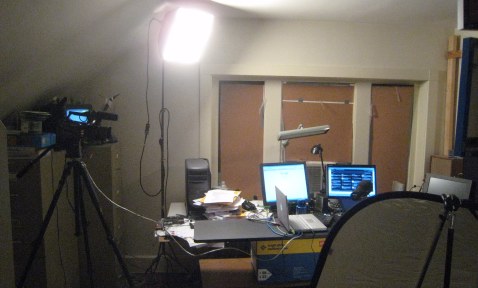 From the side, showing the camera and front light on the left, and the back of the reflector in the bottom right. There are baffles on the windows to keep out light.
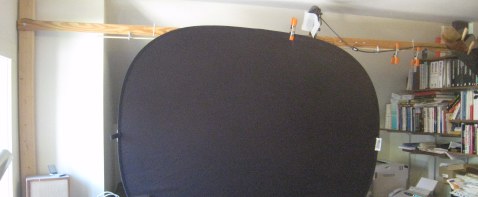 The background, with the backlight (turned off so as not to wash out this photo) clamped to the beam I built to hold it in 2004.
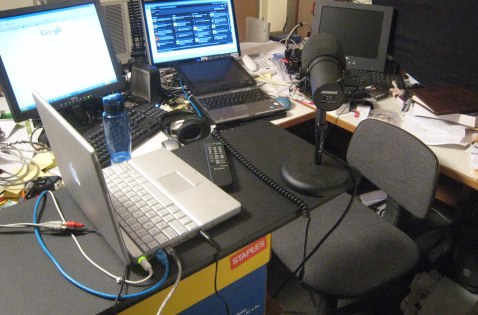 Looking at where I sat and the temporary shelf in front of me.
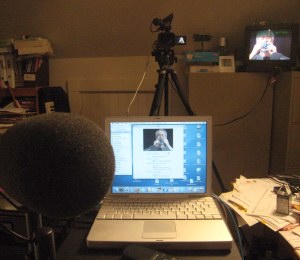 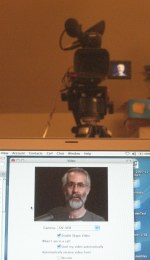 What I saw, including a TV monitor that shows what my camera sees.
Getting the Mac all set up with the new software and inputs took a while. I tried testing it by comparing it to the netbook sitting next to it, Skyping back and forth between two accounts. I tried different microphones, I had problems with my headset on the Mac and then on the netbook. Murphy kept striking as things would have problems. I sent emails to Dane to see if we could do another sound and video check, but he was too busy producing another show right before and some promotional recordings. I could watch what they were doing on another computer connected to their live feed but couldn't contact them.
It was getting close to the time for the show and I hadn't heard from them and hadn't tested the new setup with them. I had my netbook as a backup ready to be able to revert, but the headset USB connection was having problems, so I had a plugged in alternative with an old Radio Shack headset.
I noticed that with all this work and the hot lights (I'd turned off the air conditioner so there wouldn't be any sound from it) my nose was very shiny. Should I get up and powder it? Would anybody care? Suddenly, I saw Leo on the live feed take a few second break and get out a brush and powder his nose and forehead. Yes! He cared about such things, I should run into the bathroom and get my makeup and do mine. (As you'll see in the photos with the blog post I linked to above about John Dvorak, I knew that John valued such things.)
Finally, right around the time the show was scheduled to start, Skype got a video call from the show. I clicked "answer" and we were on. A little more fussing and then I was sending my video. Immediately I got comments from Leo about how good it looked and how well I sounded. Yes!!!! It was only Leo, John Dvorak, and me. John didn't have his camera set up, so only Leo and I had our images streamed.
Here's Leo listening to John talk:
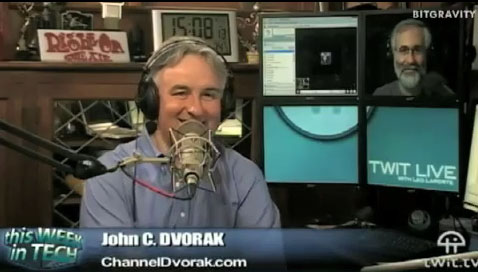 Here's what I looked like:
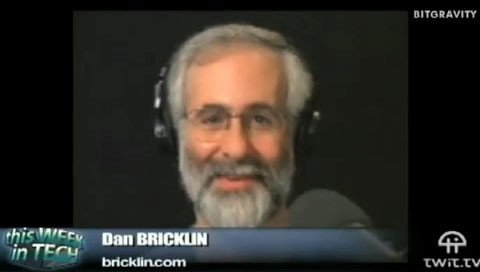 When we started recording the show the first thing Leo talked about was how good and professional my video looked. John asked if I had a black cloth behind me. I grabbed my camera's remote control and zoomed out to show my backdrop and some of the lights (you can see the reflector in the lower right):
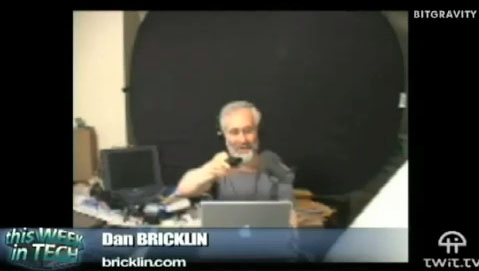 We were now three people who shared an understanding. Leo mentioned something about a 24-hour show like his but all about Twitter and I joked about how it would have to be through a tiny window, not HD, as a reference to the 140-character Twitter limit. Whew. Quick thinking, on topic, and light. We mentioned Twitter again, of course, and I made reference to a comic in that day's Sunday paper that was about Twitter. While Leo talked about something else I turned to my other computer and looked up a URL: The May 24, 2009 edition of the Jump Start comic on Comics.com. They brought that up on screen and Leo read the comic. Yay! I got to bring in something timely they hadn't seen that was funny. Maybe I could do this spontaneous chatty thing.
The rest of the show went pretty well. John said this about my book: "The book was very enjoyable, but it didn't have in my opinion, enough dirt." So we started talking a bit about the rich interbusiness and interpersonal intrigue of the early PC days and VisiCalc. I also explained how my book was about technology, and not the business story --that would take up a whole other book and was something I'd need other people to help me with and maybe I'd do someday.
It went really well. I really enjoyed the show. We talked about things from Twitter to Cloud Computing to MSDN to netbooks. Leo and Dane do a great job. They have a small wall of flat panel monitors displayed behind him, one with the live Skype video feed of each of the other participants, just like on commercial TV. I kept trying different ways of looking to see which looked best in the background. Should I stare into the camera? Should I look down at my laptop screen to see what was on the feed like Dane said others did? Should I look to my right and down as if I was looking at Leo when you saw it on TV? Hard to tell. I ended up doing a lot of just looking at the camera, trying to listen carefully. Here's me pretending like I could see Leo:
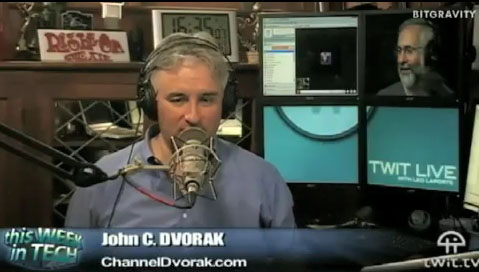 At the end Leo asked if I'd be willing to be on the show again sometime. Sure! John, I think, did, too. I started getting nice tweets from people who liked the show, and as people download it to listen, I keep seeing more. All that preparation paid off, and I guess this is a medium I can work in. Oh, and book sales started going up on Amazon.
You can go to the page for This Week in Tech Show 196 to find a link to the audio recording of the show and a transcript. There's a video copy in MP4 on ODTV. Leo and Dane give each TWiT show a different short name. This one is "Flesh Colored Tape" which refers to a discussion, and demonstration by Leo, we had about different microphones and how they sound and why you want good sound for the benefit of the listener. The tape is what Leo pointed out they use in the theater to hold the little flexible microphone conduits on actors' faces.
One of the things we talked about on the show was about authors posting videos of themselves reading from their book. I had just done one and John and Leo encouraged me to do more and to do the reading myself. After finishing with the show I just sat down in the same place and read through another section of the book to record "The Mindset of an Engineer". This time I didn't do multiple takes at different zoom levels like I had before. Editing was a lot easier. You can see that recording, and the one I did before the show, on the book's "Videos for Bricklin on Technology" page.
-Dan Bricklin, 27 May 2009
|
|
|
© Copyright 1999-2018 by Daniel Bricklin
All Rights Reserved.
See disclaimer on home page.
|